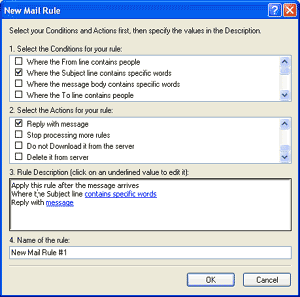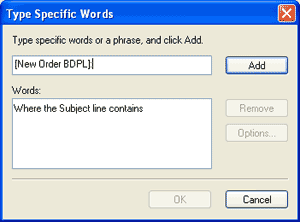So you need to send an auto reply with Outlook Express. I've got some good news and some bad news. Obviously the good news first - You can configure Outlook Express to send auto replies with the help of message rules and I shall soon detail, step by step, on how its done.
Now the bad news - the auto replies would be sent only when you check email using the computer (presumable yours) on which you have created those message rules. So if you are on holiday, your out-of-office replies would only be sent if you check emails using the Outlook Express program that has those message rules set up (which, typically, would be on your system) or create those message rules afresh on a foreign system. Thus, if you are not lugging your system around on holiday, I would suggest configuring the email server to send those auto replies.
When can the Outlook Express auto reply feature be useful?
As mentioned above, auto replies can only be sent from Outlook Express if you use the same computer to check emails which is not functional if you are away from your system. However, in some cases, you can put this to good use. For instance, if you receive orders from your web site and if those messages have a predefined email subject (they would typically), auto replies can be sent when you download the emails. Another intuitive use (an actual example) was when I was shifting office. A couple of months before the actual shifting took place, I created message rules that sent auto replies with the new office address and phone numbers to emails I received from present clients. So by the time we moved to our new premises most of our important clients already had our new address. These are simply two cases where the auto reply feature can be put to good use; I am sure you can come up with a few of your own.
Employing message rules to send auto replies in Outlook Express
If you are not aware of message rules, you have missed a very powerful feature of Outlook Express. Message rules are quite like instructions that you setup to process incoming email. For example, you can create rules to automatically sort all incoming email to specified folders,delete potential spam on the server (no need to download and check), stop the download of emails with very large attachments so that you can first check them out at the server using webmail and much more - please refer to other articles on this web site.
Let us now see how message rules can be employed to send auto replies.
Open the Message Rules window by selecting "Tools" > "Message Rules" > "Mail". There are 12 Conditions that you can set for incoming emails. We shall soon see which one is the best for your needs. The Action that we are interested in is the fourth from last, "Reply with message" - refer image below.
To create a message rule that sends an auto reply to an email with a defined subject, select the second condition - "Where the Subject line contains specific words". Orders over email from web sites will typically have a predefined. For instance, email orders from my web site have the subject [New Order BDPL]: today's date - thus, the words "New Order BDPL" are placed inside square brackets which is enough to identify the email as one coming from my web site and carrying a new order for us. (The actual date that follows the first phrase has no use in this exercise).

The image above displays the rule that we are creating. In the Rule Description box, you will notice two blue hyperlinks - contains specific words and message. Now to complete the process we need to inform the message rule of the specific words that it needs to hunt for in the email subject and give it an auto reply message. Click on the first link, enter the words and click on the "Add" button - refer image below.

Not sure if you noticed but you could have given this message rule more words/phrases to check in the email subject. Thus, you can group emails based on specific words in the subject and have all sent the auto-reply message.
The next step is to create the auto reply message. For now, open Notepad (or an equivalent text editor), type in your message and save the file as .txt. Now click on the blue messagehyperlink in the Rule Description box and select your auto reply text file. FYI, Outlook Express allows you to use a .nws (news), .eml (email), .htm or .txt file. You can provide a descriptive name and click on the "OK" button to finally create the message rule. Thus, each time you download emails, Outlook Express will scan the subject lines of all incoming messages and send the auto reply to ones that match the criterion defined in the rule.
By the way, you can send auto replies for each message you receive (check the last Condition for message rules) but that would not be a good idea because you would end up sending replies to spam messages too!
Posted By Haji
No comments:
Post a Comment